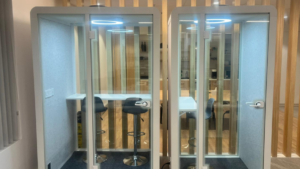Finding the right work-life balance can be a challenge for professionals, particularly those who work from home. To achieve this balance, it is important to design a home office that promotes productivity while also maintaining a comfortable and welcoming atmosphere. This article discusses ways to create a home office that promotes a healthy work-life balance. It draws on recent studies and expert advice.

Create a Dedicated Workspace:
Creating a dedicated workspace is crucial to minimizing distractions and establishing a professional environment at home. According to a study published in the Journal of Environmental Psychology, a well-defined workspace can significantly improve concentration and job satisfaction. To achieve this, choose a quiet, well-lit area of the home away from high-traffic areas to set up your office. To prevent discomfort and fatigue, it is essential to have ergonomic furniture, including a supportive chair and a desk at the right height.
Incorporate Natural Elements:
Incorporating natural elements into your home office can enhance mood and creativity. According to a study published in the Scandinavian Journal of Work, Environment & Health, exposure to natural light and greenery can reduce stress and improve mental well-being. To benefit from natural light, position your desk near a window, and to improve air quality and provide a calming presence, consider adding houseplants to your workspace.
Technology and Productivity Tools:
To work efficiently remotely, it is essential to leverage technology and productivity tools. Applications such as Trello for task management, Zoom for video conferencing, and Slack for team communication can help you stay organized and connected with colleagues. However, it is important to set boundaries with technology to avoid burnout. The American Psychological Association recommends setting specific times for checking email and messages to prevent work from encroaching on personal time.
Create a Work-life Boundary:
Maintaining a healthy work-life balance is crucial, especially when working from home where the boundaries between personal and professional life can become blurred. To achieve this, experts recommend establishing regular work hours and adhering to them as closely as possible. Additionally, physically closing your office space at the end of the workday – such as closing the door or covering your workstation – can signal to your brain that work time is over and help you transition to personal time.
Personalize Your Space:
Personalizing your home office can boost productivity and job satisfaction. Adding family photos, artwork, or a favorite coffee mug can make your office feel less corporate and more inviting. According to a study in the Harvard Business Review, personalization in workplace design can increase engagement and create a sense of ownership over one’s work.
Conclusion:
Creating a home office that supports work-life balance requires careful consideration of space, design, and personal habits. By creating a dedicated workspace, incorporating natural elements, using technology wisely, setting clear boundaries, and personalizing your office, you can foster a productive and satisfying work environment at home. As remote work becomes more prevalent, finding ways to balance professional responsibilities with personal well-being is more important than ever.
